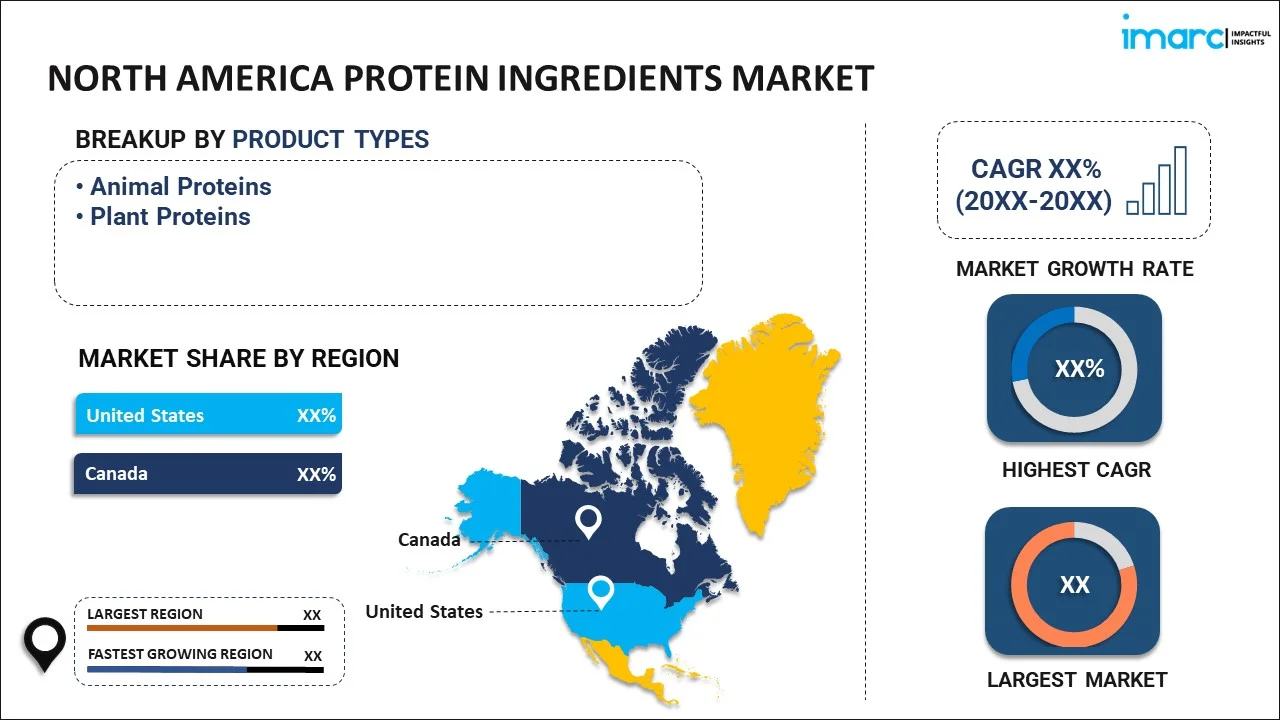
North America Protein Ingredients Market Report by Product Type (Animal Proteins, Plant Proteins), Application (Food and Beverages, Personal Care and Cosmetics, Pharmaceuticals, Animal Feed), and Country 2025-2033
Market Overview:
The North America protein ingredients market size reached USD 16.0 Billion in 2024. Looking forward, IMARC Group expects the market to reach USD 29.3 Billion by 2033, exhibiting a growth rate (CAGR) of 6.63% during 2025-2033.
|
Report Attribute
|
Key Statistics
|
|---|---|
|
Base Year
|
2024
|
|
Forecast Years
|
2025-2033
|
|
Historical Years
|
2019-2024
|
|
Market Size in 2024
|
USD 16.0 Billion |
|
Market Forecast in 2033
|
USD 29.3 Billion |
| Market Growth Rate 2025-2033 | 6.63% |
Protein ingredients consist of various amino acids which are required to maintain the protein levels in the human body. They help in improving physical strength, lowering muscle loss with aging, mitigating the risk of chronic diseases and regulating weight. Adequate consumption of proteins also helps in managing stress, improving immunity, and reducing hunger and body fat. Protein ingredients can be obtained from different sources such as animals or plants. Animal proteins are generally derived from milk, meat, fish, gelatin and egg, whereas, plant-based proteins are obtained from soy, wheat, canola, rice and pea. Animal proteins are known to have a better nutritional profile as compared to the plant proteins. The major applications of protein ingredients are in the production of dietary supplements and food products such as dairy, bakery, infant formula, beverages, etc.
North America protein ingredients market is currently being driven by several factors. Increasing availability of diverse products caters to the different tastes and preferences of the consumers, thereby stimulating the demand in the region. The product variety includes egg protein, whey protein, casein, gelatin, milk protein isolates, soy protein and wheat protein. Based on their nutritional benefits, protein ingredients find wide applications in the healthcare, personal care, cosmetics and pharmaceutical industries, thereby, inducing the market growth in the region. In addition to this, the rising health consciousness among consumers has also resulted in the escalated demand for protein-rich dietary supplements, sports nutrition products, and ready meals. Furthermore, the long-shelf life of protein ingredients makes them convenient for consumers.

Key Market Segmentation:
IMARC Group provides an analysis of the key trends in each segment of the North America protein ingredients market report, along with forecasts at the regional and country levels from 2025-2033. Our report has categorized the market based on product type and application.
- Key Regions Analysed
- United States
- Canada
- Analysis for Each Country
- Market by Product Type
- Animal Proteins
- Egg Protein
- Whey Protein
- Gelatin
- Casein
- Milk Protein Concentrates/Isolates
- Plant Proteins
- Wheat Protein
- Soy Protein
- Pea Protein
- Others
- Animal Proteins
- Market by Application
- Food and Beverages
- Personal Care and Cosmetics
- Pharmaceuticals
- Animal Feed
- Value Chain Analysis
- Key Drivers and Challenges
- Porters Five Forces Analysis
- Competitive Landscape
- Competitive Structure
- Key Player Profiles
Report Coverage:
| Report Features | Details |
|---|---|
| Base Year of the Analysis | 2024 |
| Historical Period | 2019-2024 |
| Forecast Period | 2025-2033 |
| Units | Billion USD |
| Segment Coverage | Product Type, Application, Country |
| Countries Covered | United States, Canada |
| Customization Scope | 10% Free Customization |
| Post-Sale Analyst Support | 10-12 Weeks |
| Delivery Format | PDF and Excel through Email (We can also provide the editable version of the report in PPT/Word format on special request) |
Key Questions Answered in This Report
The North America protein ingredients was valued at USD 16.0 Billion in 2024.
We expect the North America protein ingredients market to exhibit a CAGR of 6.63% during 2025-2033.
The sudden outbreak of the COVID-19 pandemic has led to the changing consumer inclination from conventional brick-and-mortar distribution channels towards online retail platforms for the purchase of protein ingredients-based dietary supplements and food products.
The rising consumer preference for protein ingredients-based dietary supplements and food products, as they aid to improve physical strength, lower muscle loss with aging, mitigate the risk of chronic diseases, regulate weight, etc., is primarily driving the North America protein ingredients market.
Based on the product type, the North America protein ingredients market has been segmented into animal proteins and plant proteins. Currently, animal proteins hold the largest market share.
Based on the application, the North America protein ingredients market can be divided into food and beverages, personal care and cosmetics, pharmaceuticals, and animal feed. Among these, the food and beverage industry exhibits a clear dominance in the market.
On a regional level, the market has been classified into United States and Canada, where United States currently dominates the North America protein ingredients market.
Need more help?
- Speak to our experienced analysts for insights on the current market scenarios.
- Include additional segments and countries to customize the report as per your requirement.
- Gain an unparalleled competitive advantage in your domain by understanding how to utilize the report and positively impacting your operations and revenue.
- For further assistance, please connect with our analysts.
 Inquire Before Buying
Inquire Before Buying
 Speak to an Analyst
Speak to an Analyst
 Request Brochure
Request Brochure
 Request Customization
Request Customization




.webp)




.webp)












